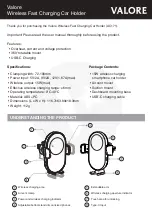
11
EN
Protecting your-
self and others
EMC Device Clas-
sifications
EMC measures
When welding, you expose yourself to numerous dangers. In addition to these
operating instructions, the safety instructions of the manufacturer of the entire
welding system must also be observed.
Keep all persons, especially children, out of the working area while any devic-
es are in operation or welding is in progress. If, however, there are people in
the vicinity,
-
make them aware of all the dangers and health risks (crushing by me-
chanically-powered parts, flying shavings and similar matter, escaping
compressed air, flying sparks, dazzling by arc, inhalation of harmful weld-
ing fumes, noise, possible danger from mains or welding current, etc.),
-
provide suitable protective equipment or
-
erect suitable safety screens/curtains.
Devices in emission class A:
-
Are only designed for use in industrial settings
-
Can cause line-bound and radiated interference in other areas
Devices in emission class B:
-
Satisfy the emissions criteria for residential and industrial areas.
This is also true for residential areas in which the energy is sup-
plied from the public low-voltage mains.
EMC device classification as per the rating plate or technical data.
In certain cases, even though a device complies with the standard limit values
for emissions, it may affect the application area for which it was designed (e.g.
when there is sensitive equipment at the same location, or if the site where the
device is installed is close to either radio or television receivers).
If this is the case, then the operator is obliged to take appropriate action to rec-
tify the situation.
Check for possible problems, and check and evaluate neighbouring devices'
resistance to interference according to national and international require-
ments:
-
Safety devices
-
Power, signal and data transfer lines
-
IT and telecommunications devices
-
Measuring and calibrating devices
Supporting measures for avoidance of EMC problems:
1.
Mains supply
-
If electromagnetic interference arises despite correct mains connec-
tion, additional measures are necessary (e.g. use a suitable line fil-
ter).
2.
Control lines
-
must be kept as short as possible
-
must run close together (to avoid EMF problems)
-
must be kept well apart from other leads
3.
Equipotential bonding
4.
Shield, if necessary
-
Shield off other nearby devices
-
Shield off entire welding installation
Summary of Contents for 4,044,008
Page 2: ...2...
Page 4: ...4...
Page 15: ...General information...
Page 16: ......
Page 24: ...24...
Page 25: ...Controls connections and mechani cal components...
Page 26: ......
Page 35: ...Installation and commissioning...
Page 36: ......
Page 65: ...65 EN 3 3...
Page 84: ...84...
Page 85: ...Troubleshooting...
Page 86: ......
Page 90: ...90...
Page 91: ...Care maintenance and disposal...
Page 92: ......
Page 126: ...126...
Page 127: ...Technical data...
Page 128: ......
Page 130: ...130...
Page 131: ...Appendix...
Page 132: ...132 Pneumatic diagram V23072012...
Page 134: ...134...
Page 135: ...135...












































